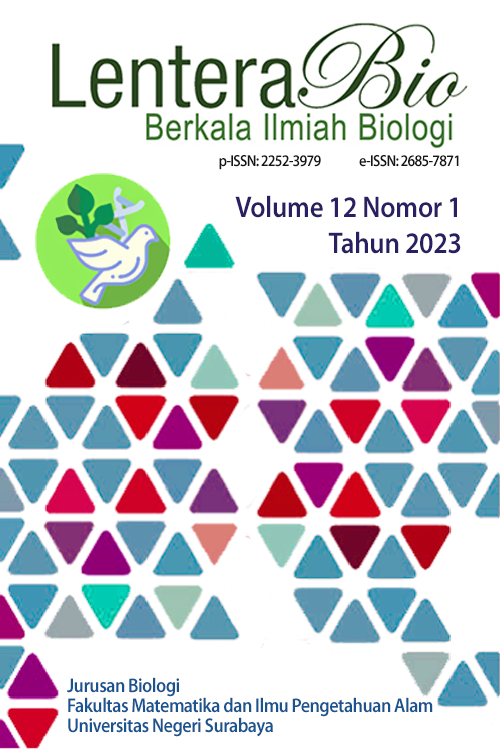The Effect of Giving Ecoenzyme as Liquid Organic Fertilizer on the Growth of Pakcoy Mustard Plant (Brassica rapa L.)
DOI:
https://doi.org/10.26740/lenterabio.v12n1.p50-59Abstract
Ecoenzymes are solutions of fermented organic waste in the form of fruit peels with brown sugar and water that can be used as organic fertilizer. The pakcoy plant is vegetable whose production can’t be separated from the use of inorganic fertilizers. This aim of the study was to describe the quality of nutrient content of N, P, K in ecoenzymes and to determine the effect and the best concentration of ecoenzymes on the growth of pakcoy. This research method used one-factorial Randomized Block Design (RBD) that was the concentration of ecoenzymes as liquid organic fertilizers with 5 treatments and 5 repetitions, including E0 (0 ml/L water); E1 (2,5 ml/L water); E2 (5 ml/L water); E3 (7,5 ml/L water); dan E4 (10 ml/L water). The observed variables were plant height, number of leaves, root length, and wet biomass of pakcoy plants. The results of the data were analyzed by one-way ANOVA, then continued by Duncan’s test at the 5% level. The results showed that the nutrients content of N, P, and K in ecoenzymes included in very low criteria, namely N = 0.07%; P = 0.04%; and K = 0.004%. The application of ecoenzymes as liquid organic fertilizer from various concentrations gave significant results on the plant growth, including plant height, number of leaves, root length, and wet biomass of pakcoy plants. The most optimal concentration that affects the growth of pakcoy plants is 10 ml/L which comes from E4 treatment.
Downloads
Published
How to Cite
Issue
Section
License
Copyright (c) 2023 LenteraBio : Berkala Ilmiah Biologi

This work is licensed under a Creative Commons Attribution-NonCommercial 4.0 International License.
Hak Cipta (c) LenteraBio: Berkala Ilmiah Biologi
Karya ini dilisensikan di bawah Lisensi Internasional Creative Commons Attribution-NonCommercial 4.0.
Pemberitahuan Hak Cipta.
Hak cipta dari artikel yang diterima untuk diterbitkan akan diberikan kepada jurnal sebagai penerbit jurnal. Hak cipta yang dimaksud meliputi hak untuk menerbitkan artikel dalam berbagai bentuk (termasuk cetak ulang). Jurnal mempertahankan hak penerbitan atas artikel yang diterbitkan.
 Abstract views: 3166
,
Abstract views: 3166
, PDF Downloads: 11392
PDF Downloads: 11392











